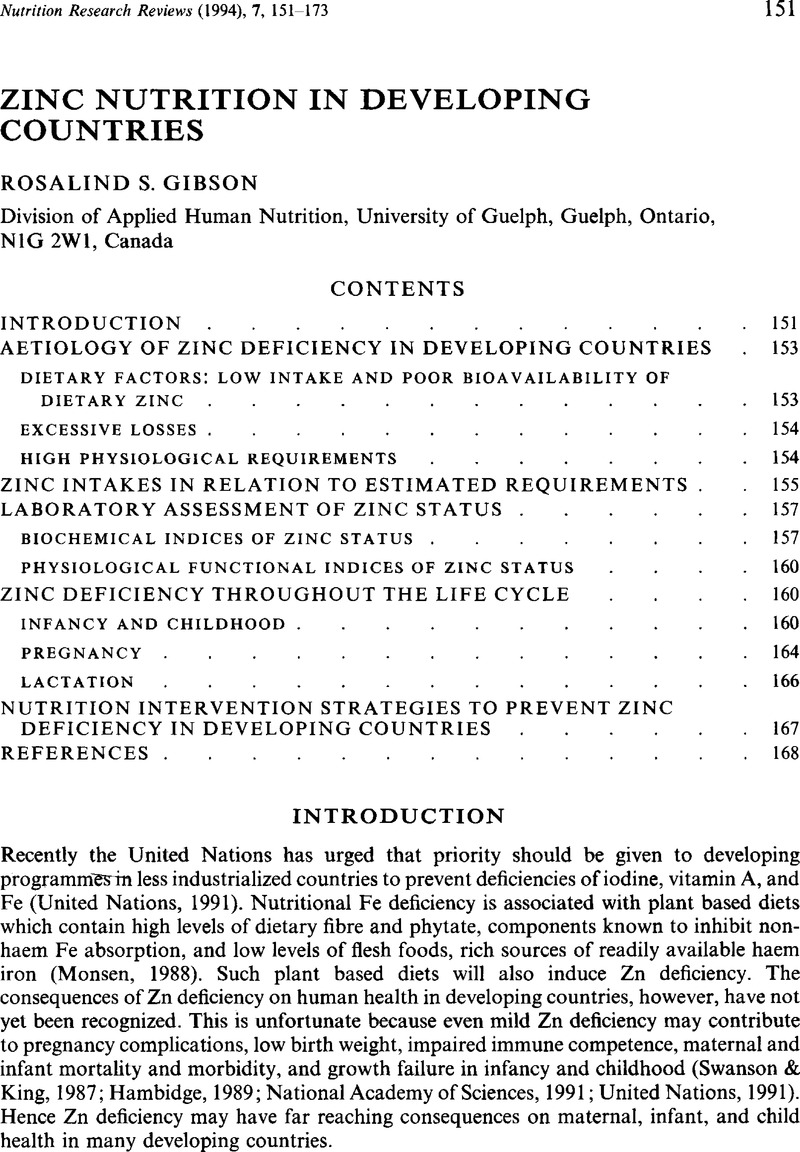Crossref Citations
This article has been cited by the following publications. This list is generated based on data provided by Crossref.
Sandstead, Harold H.
and
Smith, J.Cecil
1996.
Deliberations and Evaluations of Approaches, Endpoints and Paradigms for Determining Zinc Dietary Recommendations.
The Journal of Nutrition,
Vol. 126,
Issue. ,
p.
2410S.
Rodriguez, P
Darmon, N
Chappuis, P
Candalh, C
Blaton, M A
Bouchaud, C
and
Heyman, M
1996.
Intestinal paracellular permeability during malnutrition in guinea pigs: effect of high dietary zinc..
Gut,
Vol. 39,
Issue. 3,
p.
416.
Gilabert, E.R.
Ruiz, E.
Osorio, C.
and
Ortega, E.
1996.
Effect of dietary zinc deficiency on reproductive function in male rats: Biochemical and morphometric parameters.
The Journal of Nutritional Biochemistry,
Vol. 7,
Issue. 7,
p.
403.
Zapata, Carmiña L. Vargas
Simões, Tania M. R.
and
Donangelo, Carmen M.
1997.
Erythrocyte metallothionein in relation to other biochemical zinc indices in pregnant and nonpregnant women.
Biological Trace Element Research,
Vol. 57,
Issue. 2,
p.
115.
Hambidge, KM
1997.
Zinc deficiency in young children.
The American Journal of Clinical Nutrition,
Vol. 65,
Issue. 1,
p.
160.
Sandstead, Harold H.
and
Alcock, Nancy W.
1997.
Zinc: An essential and unheralded nutrient.
Journal of Laboratory and Clinical Medicine,
Vol. 130,
Issue. 2,
p.
116.
Gibson, Rosalind S
and
Ferguson, EL
1998.
Assessment of dietary zinc in a population.
The American Journal of Clinical Nutrition,
Vol. 68,
Issue. 2,
p.
430S.
Leemon, Melanie
and
Samman, Samir
1998.
A food‐based systems approach to improve the nutritional status of Australian aborigines: A focus on zinc.
Ecology of Food and Nutrition,
Vol. 37,
Issue. 6,
p.
523.
Allen, Lindsay H
1998.
Zinc and micronutrient supplements for children.
The American Journal of Clinical Nutrition,
Vol. 68,
Issue. 2,
p.
495S.
Brown, Kenneth H
1998.
Effect of infections on plasma zinc concentration and implications for zinc status assessment in low-income countries.
The American Journal of Clinical Nutrition,
Vol. 68,
Issue. 2,
p.
425S.
Gibson, Rosalind S.
and
Ferguson, Elaine L.
1998.
Nutrition intervention strategies to combat zinc deficiency in developing countries.
Nutrition Research Reviews,
Vol. 11,
Issue. 1,
p.
115.
Ruel, Marie T
and
Bouis, Howarth E
1998.
Plant breeding: a long-term strategy for the control of zinc deficiency in vulnerable populations.
The American Journal of Clinical Nutrition,
Vol. 68,
Issue. 2,
p.
488S.
Sandstead, Harold H
Penland, James G
Alcock, Nancy W
Dayal, Hari H
Chen, Xue C
Li, Jui S
Zhao, Faji
and
Yang, Jia J
1998.
Effects of repletion with zinc and other micronutrients on neuropsychologic performance and growth of Chinese children.
The American Journal of Clinical Nutrition,
Vol. 68,
Issue. 2,
p.
470S.
Berti, Peter R.
Leonard, William R.
and
Berti, Wilma J.
1998.
Stunting in an Andean community: Prevalence and etiology.
American Journal of Human Biology,
Vol. 10,
Issue. 2,
p.
229.
Rivera, Juan A.
Ruel, Marie T.
Santizo, Maria Claudia
Lönnerdal, Bo
and
Brown, Kenneth H.
1998.
Zinc Supplementation Improves the Growth of Stunted Rural Guatemalan Infants.
The Journal of Nutrition,
Vol. 128,
Issue. 3,
p.
556.
Paul, Alison A.
Bates, Christopher J.
Prentice, Ann
Day, Kenneth C.
and
Tsuchiya, Harumi
1998.
Zinc and phytate intake of rural Gambian infants: contributions from breastmilk and weaning foods.
International Journal of Food Sciences and Nutrition,
Vol. 49,
Issue. 2,
p.
141.
Hambidge, Michael
and
Krebs, Nancy
1999.
Zinc, diarrhea, and pneumonia.
The Journal of Pediatrics,
Vol. 135,
Issue. 6,
p.
661.
Penny, Mary E.
Peerson, Janet M.
Marin, R.Margot
Duran, Augusto
Lanata, Claudio F.
Lönnerdal, Bo
Black, Robert E.
and
Brown, Kenneth H.
1999.
Randomized, community-based trial of the effect of zinc supplementation, with and without other micronutrients, on the duration of persistent childhood diarrhea in Lima, Peru.
The Journal of Pediatrics,
Vol. 135,
Issue. 2,
p.
208.
Ruz, Manuel
Codoceo, Juana
Galgani, Jose
Muñoz, Luis
Gras, Nuri
Muzzo, Santiago
Leiva, Laura
and
Bosco, Cleofina
1999.
Single and Multiple Selenium-Zinc-Iodine Deficiencies Affect Rat Thyroid Metabolism and Ultrastructure.
The Journal of Nutrition,
Vol. 129,
Issue. 1,
p.
174.
Bouis, Howarth E
1999.
Economics of enhanced micronutrient density in food staples.
Field Crops Research,
Vol. 60,
Issue. 1-2,
p.
165.



